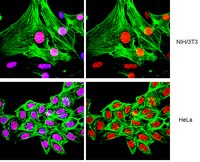Hira-mediated h3.3 incorporation is required for DNA replication and ribosomal RNA transcription in the mouse zygote.
Lin, CJ; Koh, FM; Wong, P; Conti, M; Ramalho-Santos, M
Developmental cell
30
268-79
2014
Show Abstract
Extensive chromatin reprogramming occurs at fertilization and is thought to be under the control of maternal factors, but the underlying mechanisms remain poorly understood. We report that maternal Hira, a chaperone for the histone variant H3.3, is required for mouse development past the zygote stage. Male pronucleus formation is inhibited upon deletion of Hira due to a lack of nucleosome assembly in the sperm genome. Hira mutant oocytes are incapable of developing parthenogenetically, indicative of a role for Hira in the female genome. Both parental genomes show highly reduced levels of DNA replication and transcription in the mutants. It has long been thought that transcription is not required for zygote development. Surprisingly, we found that Hira/H3.3-dependent transcription of ribosomal RNA is required for first cleavage. Our results demonstrate that Hira-mediated H3.3 incorporation is essential for parental genome reprogramming and reveal an unexpected role for rRNA transcription in the mouse zygote. | 25087892
 |
Long-range transcriptional control of progesterone receptor gene expression.
Bonéy-Montoya J, Ziegler YS, Curtis CD, Montoya JA, Nardulli AM
Molecular endocrinology (Baltimore, Md.)
24
346-58
2010
Show Abstract
Estrogen receptor alpha (ERalpha) binds to specific target DNA sequences, estrogen response elements (EREs), to regulate estrogen-responsive gene expression. The progesterone receptor (PR) gene has been used extensively as a marker of estrogen responsiveness. Although we previously identified cis elements within 1 kb of the PR-B transcription start site that are associated with ERalpha and help to confer estrogen responsiveness, the identification of ERalpha binding sites far removed from the transcription start site suggested that long-range regulation of this gene may occur. We now show that eight regions of the PR gene from 311 kb upstream to 4 kb downstream of the PR-B transcription start site interact with ERalpha and that coactivator proteins and acetylated histones are selectively associated with these gene regions. Specific PR gene regions confer estrogen responsiveness to a heterologous reporter plasmid, and mutation of EREs within these regions diminishes estrogen-induced transactivation. Importantly, chromosome conformation capture assays reveal ERalpha- and ligand-dependent interactions between proximal and distal PR gene regions. Taken together, our studies suggest that distal regions of the PR gene participate in the dynamic regulation of this gene and that the coordinated action of proximal and distal PR gene regions allows cells to respond to changes in hormone levels with extraordinary versatility and sensitivity. Full Text Article | 19952285
 |
Drug inhibition of HDAC3 and epigenetic control of differentiation in Apicomplexa parasites.
Bougdour, Alexandre, et al.
J. Exp. Med., 206: 953-66 (2009)
2009
Show Abstract
Plasmodium and Toxoplasma are parasites of major medical importance that belong to the Apicomplexa phylum of protozoa. These parasites transform into various stages during their life cycle and express a specific set of proteins at each stage. Although little is yet known of how gene expression is controlled in Apicomplexa, histone modifications, particularly acetylation, are emerging as key regulators of parasite differentiation and stage conversion. We investigated the anti-Apicomplexa effect of FR235222, a histone deacetylase inhibitor (HDACi). We show that FR235222 is active against a variety of Apicomplexa genera, including Plasmodium and Toxoplasma, and is more potent than other HDACi's such as trichostatin A and the clinically relevant compound pyrimethamine. We identify T. gondii HDAC3 (TgHDAC3) as the target of FR235222 in Toxoplasma tachyzoites and demonstrate the crucial role of the conserved and Apicomplexa HDAC-specific residue TgHDAC3 T99 in the inhibitory activity of the drug. We also show that FR235222 induces differentiation of the tachyzoite (replicative) into the bradyzoite (nonreplicative) stage. Additionally, via its anti-TgHDAC3 activity, FR235222 influences the expression of approximately 370 genes, a third of which are stage-specifically expressed. These results identify FR235222 as a potent HDACi of Apicomplexa, and establish HDAC3 as a central regulator of gene expression and stage conversion in Toxoplasma and, likely, other Apicomplexa. | 19349466
 |











